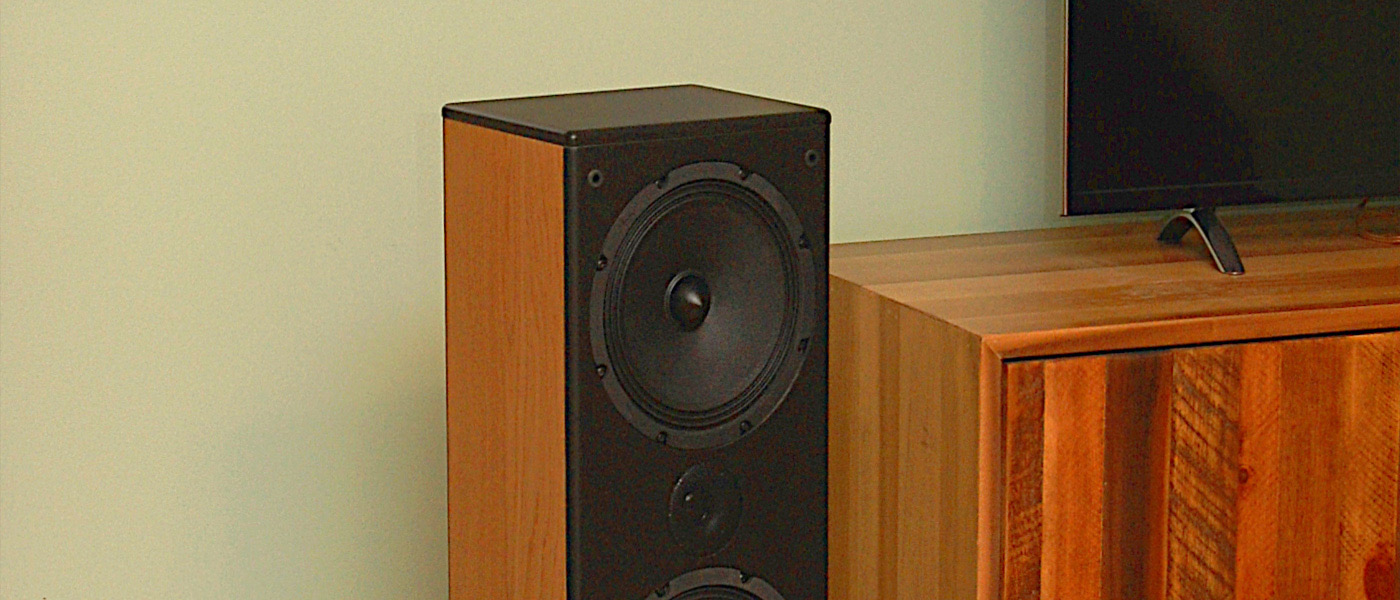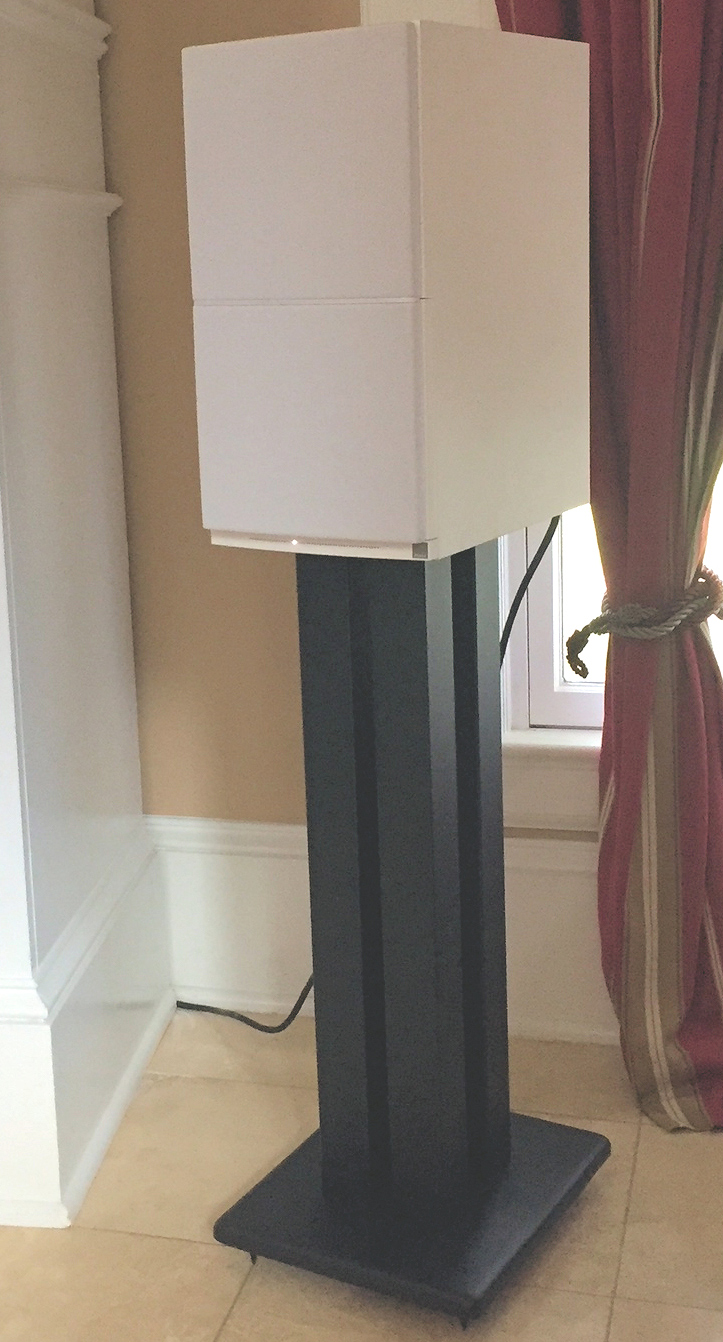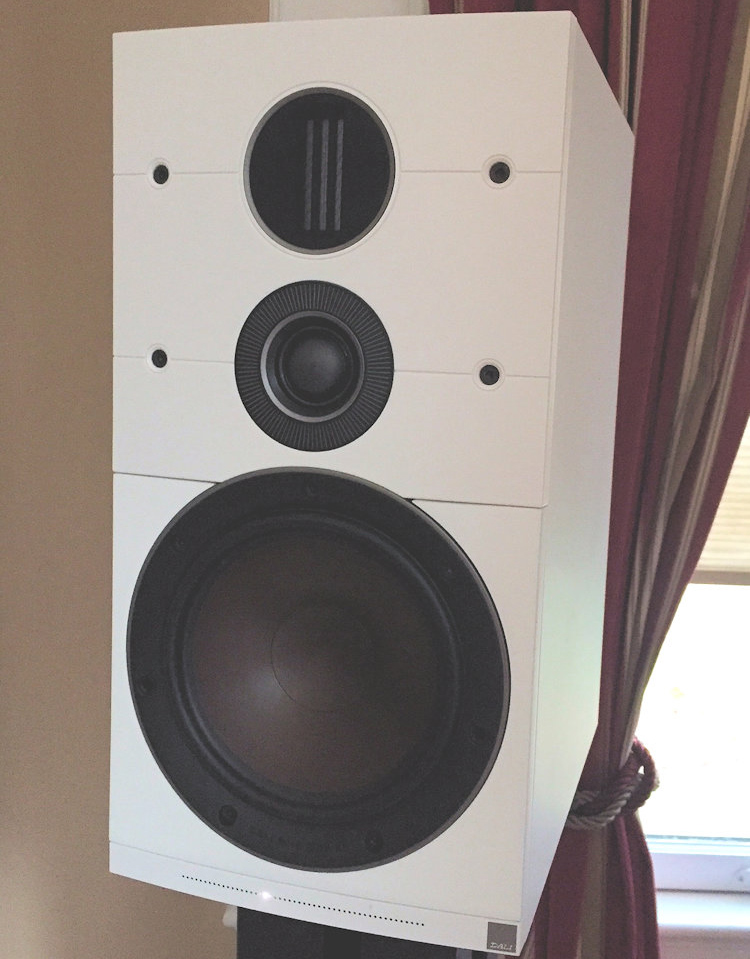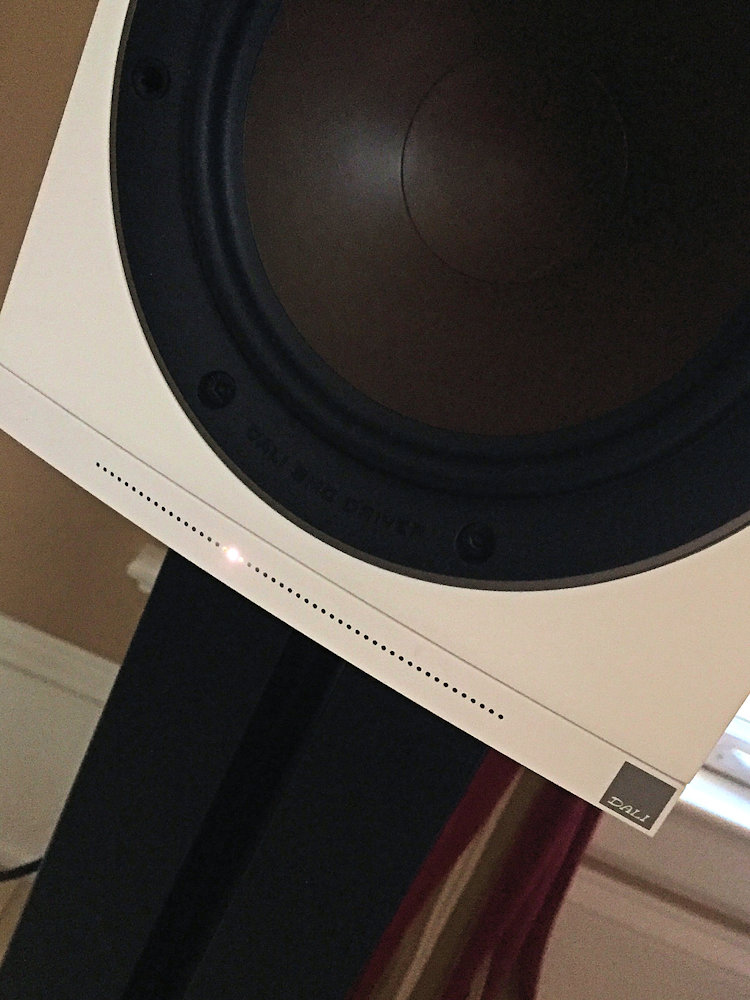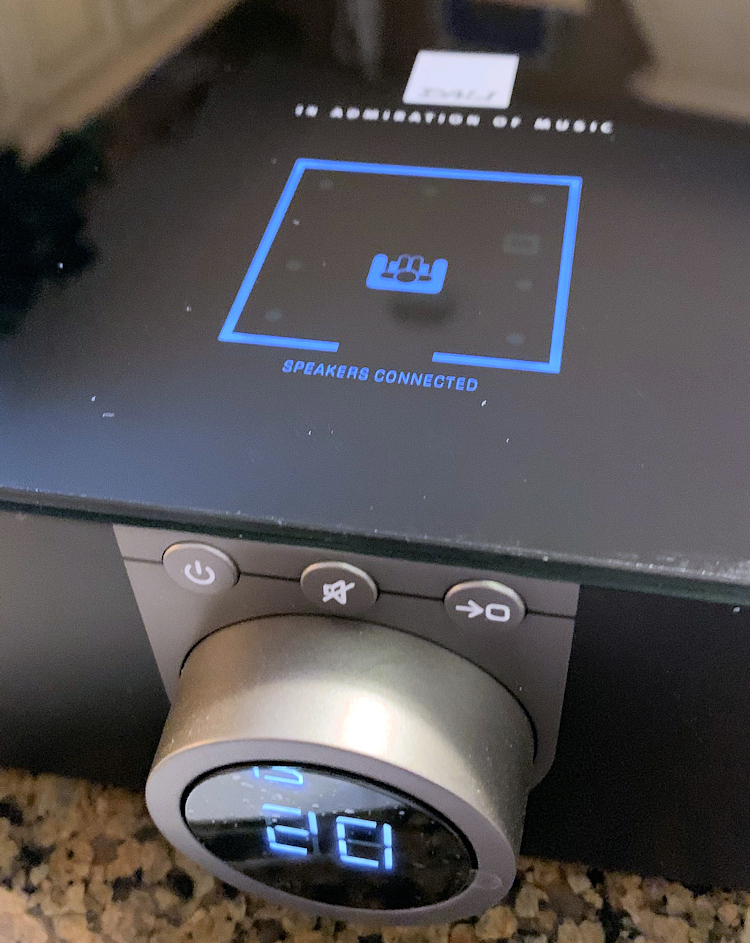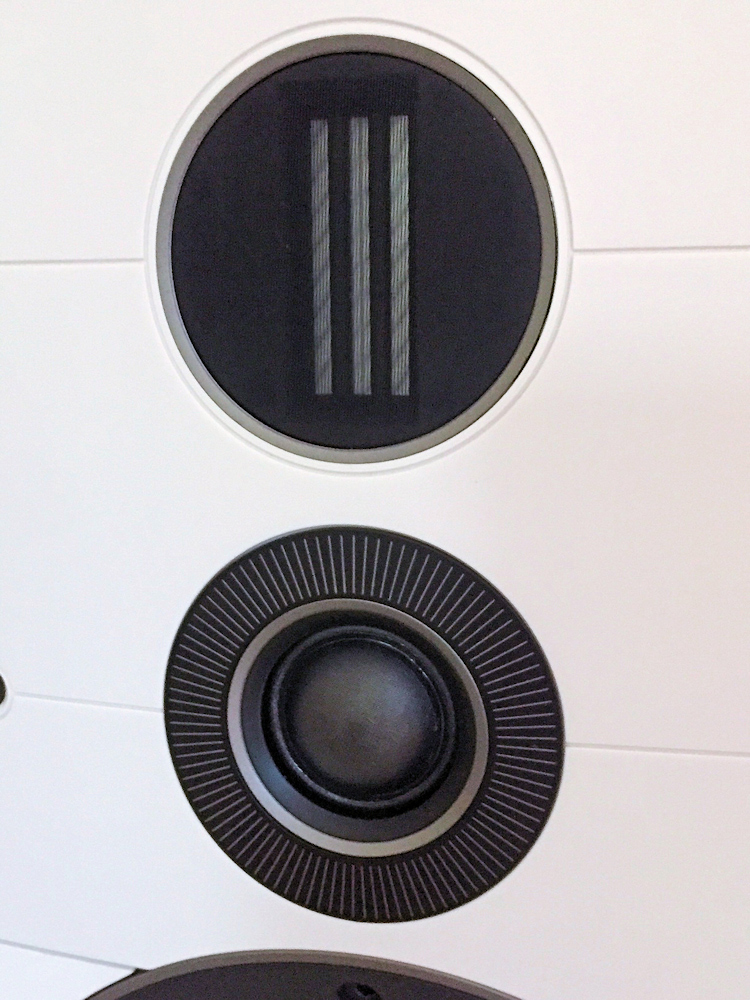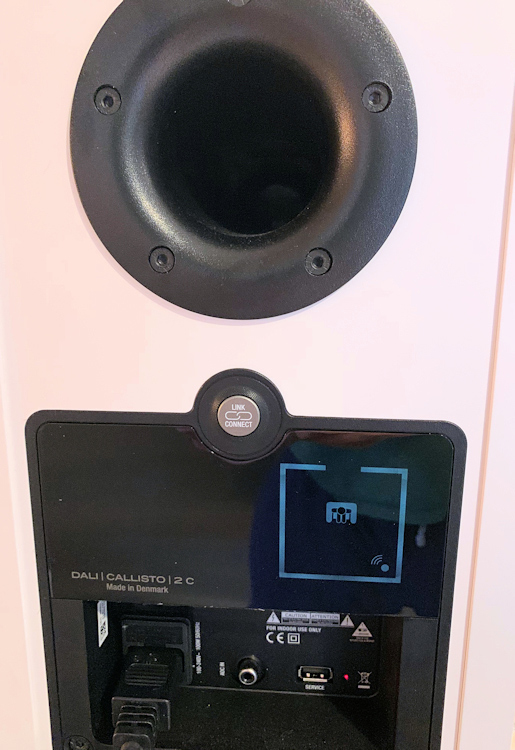The speakers are controlled by the DALI Sound Hub, the accompanying, optional component that allows multiple inputs both analog and digital and feeds the speakers wirelessly. The Sound Hub is designed with available rear slots for two expansion modules. My review unit arrived with a slot occupied by the BluOS module from Bluesound, giving the system access to the platform’s high-resolution audio and multi-room capability.
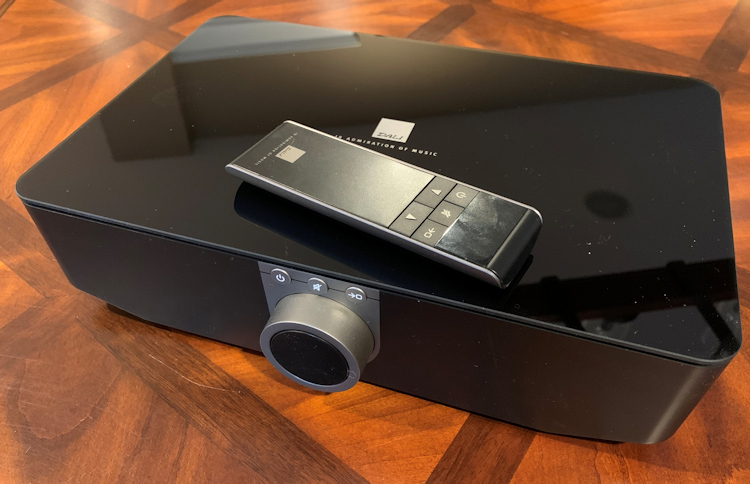
DALI Callisto 2C Speakers with BluOS Module
- Powered and wireless speaker
- Sound Hub controller
- BluOS module with app
- High-Res playback
- Wi-Fi and Bluetooth access
DALI Callisto 2C (Bass Reflex)
Frequency Response:
(+/-3dB) 47-30,000 Hz
Crossover Frequency:
2,700 Hz
Hybrid tweeter:
Super high frequency diaphragm-type ribbon driver
1 x 17 x 45 mm and 1 x 29 mm soft dome
Low Frequency Driver:
6 1/2” wood-fiber
Amplifier:
Class D 250 watts
Wireless Input:
Full 24 Bit/96 kHz
Dimensions (HxWxD) mm/in:
393 x 200 x 321 / 15.5 x 7.9 x 12.7
Weight kg/lbs:
10.1 / 22.3
DALI SOUNDHUB
Inputs:
2 x Optical (TosLink), Digital Coax (S/PDIF)
RCA (Analog Stereo), 3.5 mm mini-jack
2 x Plug-in module, Stereo Line level (RCA)
Sub-out:
(RCA)
USB Charge:
(5V/1A)
Digital Resolution:
Full 24 Bit / 96 kHz (No bit-loss attenuated)
Wireless Input:
Bluetooth 4.2 (AAC, Apt-X, Apt-X HD)
Dimensions mm/in:
76 x 300 x 213 / 3.0 x 11.8 x 8.4
Weight kg/lbs:
1.6 / 3.2
Bluesound Module
WIFI bitrate up to 24bit/192kHz
BluOS Controller App
Supports: MQA, Tidal, Spotify Connect, Slacker
Connects DALI Callisto to home Wi-Fi
MSRP:
2C – $4,750.00
6C – $5,750.00
SECRETS Tags:
Callisto 2C, Dali Speakers, BluOS Module, Floorstanding Speakers Review 2019
As described, the system includes the Callisto 2C powered, wireless monitor speaker and the DALI Sound Hub controller fitted with the BluOS module. The stand-mounted 2C is modestly scaled, about 15” high, 8” wide and 12.5” deep, weighing about 22 pounds. Available in either black or white, I asked for white better suiting our home decor. The front screen covers a hybrid tweeter design, a light-weight dome complimenting a diaphragm-type ribbon. Low and mid-frequencies are handled by DALI’s 6 1/2” wood-fiber driver developed from their Opticon and Rubicon speaker lines.
It’s no surprise to find a precisely cut, DALI-made, speaker cabinet, even vinyl-clad (if you’d prefer the main body to be of wood, opt for the black ash), it appears luxurious. Cut from solid MDF, the 25 mm thickness along with internal bracing provides the chassis rigidity and stiffness. The ubiquitous knuckle-tap confirmed the sense of solidity.
Gain adjustment are indicated by an LED light that “scrolls” across the bottom implying the volume level and the commands sent by the Sound Hub.
This may be important if you opt to hide the Hub and the display on the face that indicates the volume level. One techie and tactile feature is the touch controls built into the speaker which allows running your finger over the top, front edge, raising the volume (on both speakers) or muting with a tap.
On the rear, a large cabinet port tops a lit display indicating the connectivity to the Sound Hub, more on that in a bit. Because each speaker is individually powered, each speaker must be near an outlet. Additionally, the rear sports a service USB port and on/off switch. Each 2C speaker is outfitted with a discrete Class D amplifier. DALI claims it will deliver 250 watts for up to 5 seconds for those dynamic passages.

The Callisto 2C can be purchased without the Sound Hub and using the ADC line connection on the rear, it can be fed signals from another source, however at a fixed gain meaning your pre-amp takes control. The onboard DAC is a Burr-Brown PCM1796.
It is best however, to pair it up with the designated Sound Hub; not only will you get to control the speaker volume, but all the input sources afforded via the Hub. The Sound Hub, aptly named, is the anchor component that comes paired with a remote control. The Sound Hub communicates with the 2C speakers wirelessly at a rate of up to 24 bit/96kHz in either the 2.4 GHz or the 5.8 GHz band.
Secrets Sponsor
The Sound Hub includes both analog and digital source inputs; DALI incorporated Bluetooth, including Apt-X and Apt-X HD, optical and coax or RCA line level. With the BluOS app on my phone or tablet, I can control the system through my Wi-Fi.
The Sound Hub has an automatic sensing feature, it knows what input it’s receiving. That includes activating the speakers as well. The smartly styled component has a large round centered dial that can control the volume, digitally indicated in the middle numerically. Three buttons above the large dial include an on/off button, muting and input selection, each input having its own symbol replicated on the remote control. Again, all important if you’re hiding the Hub away without immediate access.
The top of the Sound Hub does have a lit display of the speakers attached and once they’ve connected, it indicates so. All part of the connectivity which I’ll describe shortly, but what I will say is the Sound Hub can control up to 10 speakers in multiple rooms, or as I’ve been told, potentially surround speakers. Which brings me to the modules optional to the Hub, hints of an HDMI module and therefore multi-channel surround?
More interesting for the time being, is the BluOS module outfitted on my sample Sound Hub. The Bluesound developed hardware and software allows the Hub to be controlled via the BluOS app which can access infinite number of source material from; internet radio, typical sources (Spotify, Tidal, etc.) but also any music within your network including stored on your phone or tablet. The BluOS module will also decode MQA files.
To further emphasize the multi-room ability of the BluOS platform, I was sent the Bluesound Pulse 2 tabletop speaker.
Read Chris Eberle’s excellent review here.
I placed the 2C on 24” tall steel speaker stands keeping them about 16” from the rear wall and about 9 ft apart. The Callisto manual has some very specific recommendations for room placement. I found no discernible difference in imaging and soundstage whether I toed-in or not. Each speaker is plugged in and turned on, likewise for the Sound Hub.
Connecting to the speakers wirelessly is beyond simple, each speaker has a button on the rear that once pressed, finds the Sound Hub. The Hub has the same lit button that needs to be pressed first referred to as the Link & Connect” button. The display on each device, speaker or Hub, then indicates connectivity including designating the speaker as left or right.
I cannot say straight out that I didn’t have my issues in setting up the system with my inconsistent Wi-Fi, I did find the Sound Hub works smoothly via Bluetooth and I encouraged the many visitors we’ve had during this time of year, to use Bluetooth.
With both the speakers and Hub fitted with a USB slot, I should have probably searched for firmware updates but didn’t.
I’m a believer in speaker break-in and apparently so does DALI, recommending at least 100 hours of burn-in before getting the smoothest and most dynamic response – perhaps my ears became accustomed to the sound, but I will say the Callisto 2C evolved, opened up. Most obvious, the bass felt fuller, slightly deeper.
I will say the 2C was a bit bass shy but certainly not inadequate. The Sound Hub does provide as mentioned, a subwoofer output but I felt I wanted to evaluate the 2C on its own merit.
I’ve become hooked on the Tidal music streaming service frankly. I’m not up to par on downloaded high-res music as much as I’d like to be, although I’ve plenty to use for evaluating gear. Nonetheless, I did play some of the other music servers but happily defaulted to Tidal. The BluOS module, able to decode MQA, (offered on Tidal) is the perfect companion to the Callisto 2C and DALI Sound Hub.
The Callisto 2C offered lovely playback at both low and high-volume levels – at low levels I’m able to decipher details that normally require more gain, volume. At higher volume, there was no strain or distortion. At least at the levels I’d ever want to hear.
Secrets Sponsor
I’d also venture to say, if it’s important to anyone, that the DALI Callisto 2C didn’t play favorites with genre – heavy-bass rock music may suffer slightly but acoustic-based music sounded superb, detailed and rich. Classical music, predominately chamber music I listen to, also sounded exceptionally detailed – instruments decipherable and articulate. Voices also come across as warm and tonally-correct.
I found particularly that I enjoyed piano music, which I found expressive and richly harmonic. The same from string instruments – violins never sounded bright. The Callisto 2C is able to play convincingly the richness and depth of wood instruments while producing the fine metallic sounds of brass, like trumpets.
Although the soundstage and image are solid, there is an open and expansiveness to the sound, perhaps it’s my larger open living space but nonetheless the 2C is a room-filler.
What I kept telling myself about the Callisto system was about the convenience, this was remarkably easy to turn on and listen to high-res audio, with the help of the BluOS module. Nonetheless, by the time I was done reviewing the 2C, I no longer considered convenience as the foremost feature, it became apparent that the sound took center stage.
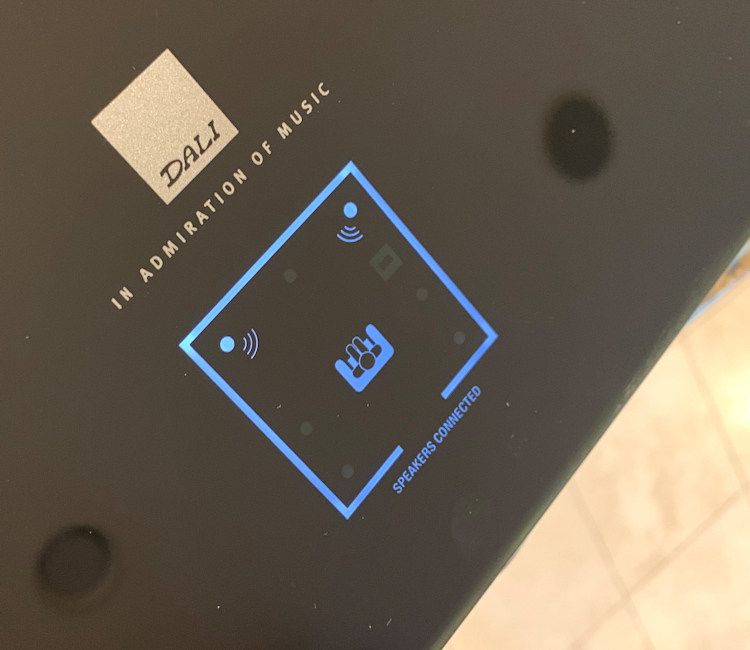
- Speaker Design
- Fancy volume LED indicator and cabinet-controlled volume
- Rich sound
- Sound Hub controls, thorough input/output options
- Hide the Sound Hub away
- Auto on/off
- BluOS module with High-Res audio playback
- Typical WiFi setup issues
My Wi-Fi issues aside, I do want to mention that the system can be glitchy; my BluOS app found the Sound Hub one day and not the next, the Sound Hub on occasion would “freeze-up” meaning I couldn’t control the volume or switch inputs with either the app or the remote control. The only solution would require a quick reboot before quickly returning to normal. Admittedly in fairness, I hadn’t tried to update the software via the rear connection in either the Sound Hub or the speakers. I’m sure it’s an easy fix.
But what I got out of the system was far more rewarding than the minor issues. I can say with so many in my house using the Callisto/BluOS system that it brought fun to high-end audio. I encouraged everyone to use it, enjoy it, and listen to excellent playback. I don’t offer the same with my “precious” two-channel system hidden away in my private room.
Some may cringe at the price tag of the system; $4,750 buys you the DALI 2C monitors, the DALI Sound Hub and the BluOS module.
But let’s break that down.
The speakers are self-powered, saving you the typically more expensive outboard amplifiers. Secondly, the speakers are wireless to the Sound Hub, good quality speaker cables can be expensive. Let’s not forget the built-in DAC. The Sound Hub acts not only as a pre-amp on its own or in your system, accepting all the inputs but also provides Wi-Fi and Bluetooth connectivity – bringing together all music sources in your system with the BluOS module, and in high-res audio! And finally, the ability to grow and evolve with the modular design. New hardware can and will be developed. Certainly, hardware becomes obsolete but the ability to upgrade software has intrinsic value.
It wasn’t long ago, audiophiles would scoff at the idea alone, of self-powered speakers with the preference for outboard amplifiers. This may have more to do with having the choice for amplifier options, than with the Class-D amps typically used for built-in amplification. Secondly, Class-D has been described as clinical sounding, less-lush than either analog tubes or alternatively solid state. I’d argue that has changed, several major speaker brands have adopted built-in amplification in “high-end” gear. Class-D is more efficient than Class-A or A/B designs, runs cooler and can incorporate DSP processing. In the case of the Callisto, a perfect application.
For more information on the DALI Callisto 2C Speakers and BluOS Module, go to https://www.dali-speakers.com/loudspeakers/callisto/callisto-2-c


